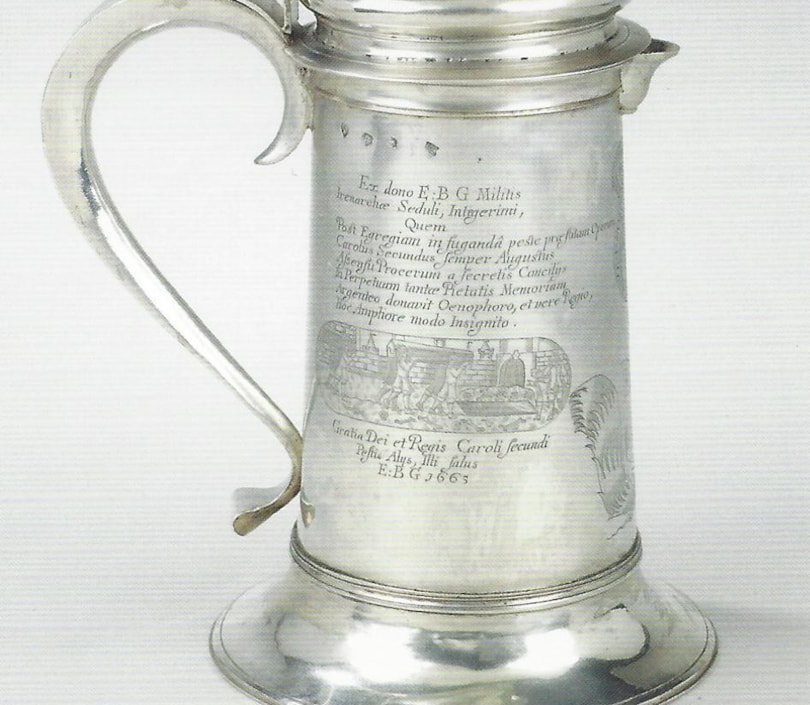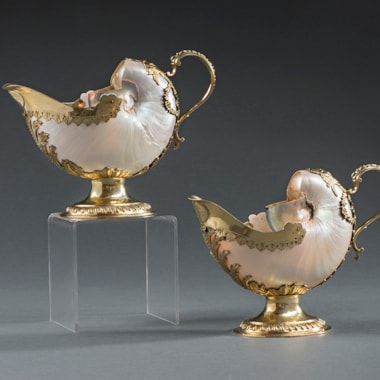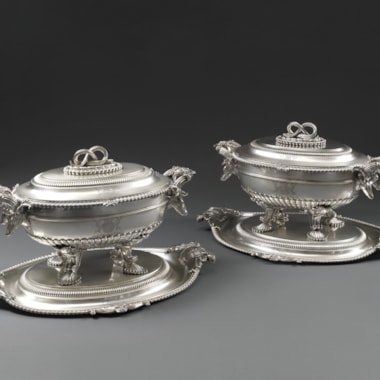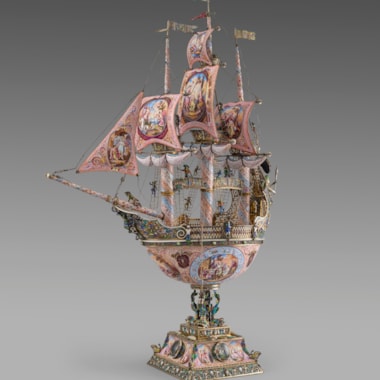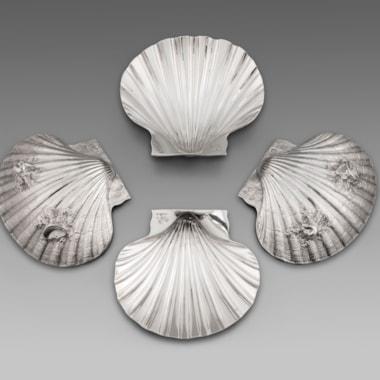The tapering cylindrical flagon has a spreading foot with moulded edge, with a band of moulding at the junction of the body and the foot and below the rim, with plain scroll handle with shaped thumbpiece and a small spout. With flat cushion-shaped cover. The sides of the body are engraved with an inscription and two scenes within elongated cartouches and the front of the flagon is engraved with a coat of arms below the Royal arms, garter motto and crown. One cartouche contains a depiction of a burial at the time of the Plague and the other is of old St. Paul’s Cathedral at the time of the Great Fire of London surrounded by burning buildings.
The inscription on one side reads: “Ex dono E:B G Militis/ Irenchae Seduli, Integernn,/ Quem/ Post Egregiam in fuganda peste praeftitam Operam,/ Carolus Secundus Semper Augustus/ Afsenfu Procerum a Secretis Concilys/ In Perpetuam tantae Pietatis Memoriam/ Argenteo donavit Oenophoro, et vere Regio,/ Hoc Ampliore modo Insignito” - “The gift of Sir Edmund Berrie Godfrey, an active and upright magistrate who, after having rendered invaluable service in checking the progress of the plague, received from King Charles II with the consent of his Privy Council, a silver wine container to perpetuate the memory of his patriotic efforts”.
“Gratia Dei et Regis Caroli Secundi/ Pestis Alys, Illi Satus E:B G 1665” – “By the grace of God and the favour of King Charles II. Other woes were his weal. EBG 1665”.
The inscription on the other side reads: “Vir revera Reipublicae Natus,/ Cum urbem Imanis vastabat Ignis,/ Dei Providentia et virtute sua/ Flamarum medio, Tutus et Illustris,/ Deinde Cogente Rege (At Merito) Emicuit Eques Auratus/ E:GB: 7 brs 1666/ Caetera Loquentur Pauperes et Trivia” - “A man truly born for his country. When a terrible fire devastated the city, by the Providence of God and his own merit he moved in safety through the flames. Afterwards, at the express desire of the King (but deservedly so), Edmund Berrie Godfrey was created a Knight in September 1666. For the rest, let public report speak”.
The tapering cylindrical tankard has a band of moulding to the foot and a slightly everted rim, with scroll handle and bifurcated thumbpiece; the flat cover has a wide rim. It is engraved with a Latin inscription and two cartouches engraved with similar scenes to those on the flagon. It is further engraved opposite the handle with a coat of arms and the Royal arms, garter motto and crown. It is also engraved with a nearly identical inscription.
The flagon, together with a group of six tankards (of which this tankard is one) often referred to as “Fire of London” tankards, was commissioned by the London magistrate Sir Edmund Berrie Godfrey (1621-1678). These pieces form one of the most historic and significant groups of silver of the period. The circumstances of their commission and the evocative engraving add considerably to their interest. All of the pieces, except for one tankard of 1673, are marked for 1675.
Godfrey gave the tankards to his friends to commemorate his activities during the Plague of 1665 and the Fire of London of 1666. One of the tankards which descended from the original recipient, Thomas Lamplugh, Archbishop of York, is on loan to the Victoria and Albert Museum, another is in the Museum of London and another one was sold at Dukes, Dorchester having previously been on loan to the Ashmolean Museum, Oxford.
Edmund Godfrey was a merchant dealing in firewood, timber and coal and Justice of the Peace for Westminster. He played an active role in tackling the problems of both the Plague and the Fire of London and was rewarded by Charles II with a knighthood and the substantial gift of 800 ounces of white plate which was authorised to be handed to him by the Jewel House in October 1666; Alan Marshall (Dictionary of National Biography) states that he initially refused the gift as he sought no reward for his actions. Charles Oman (see Literature) suggested that the original gift of plate might have been a wine cooler which was then melted down to provide the metal for this flagon and the group of tankards. Samuel Pepys however noted in his diary entry for 1st May 1667 “My seeing at Sir Robert Viners (the Royal Goldsmith) 2 or 3 great silver flagons made with inscriptions as gifts for the King to such and such persons of quality as did stay in Town the late great Plague for the keeping of things in order” which makes it more likely that the original object was one of these flagons.
In 1678 Godfrey was murdered on Primrose Hill, then on the outskirts of London and the circumstances of his death remain a mystery. It was believed that he was killed by Roman Catholics in revenge for him having been the magistrate to whom Titus Oates gave his deposition revealing the details of the ‘Popish Plot’. The aim of the plot was to threaten the life of Charles II, to overthrow the king and the government and to re-establish Catholic rule in England; Oates, together with Dr. Israel Tongue, was the main fabricator of this story. By the time that Oates’s perjury was revealed thirty-five people had been implicated, tried and executed as a result of his evidence. His death was significant in that it fed the growing anti-Catholic hysteria of the time and led to further persecution and executions.
The flagon marked on side of body and on cover and part marked on handle. The tankard marked on the side of body and on cover and part marked on back of handle
Sir Edmund Bury Godfrey
The Earls of Lonsdale
The Worshipful Company of Farmers
Charles Oman, English Engraved Silver 1150-1900, pp. 65-66
Roger Lushington, The Tankards of Sir Edmund Bury Godfrey, Connoisseur, CXC, 1975, pp. 258-265
James Charles, Heritage of England: Silver through ten reigns, 1983, No. 21, pp. 79-80
You May Also Like




































































